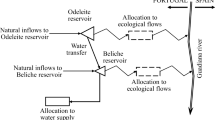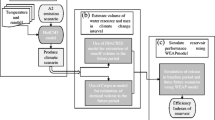Abstract
This study begins with the premise that current reservoir management systems do not take into account the potential effects of climate change on optimal performance. This study suggests an approach in which multi-purpose reservoirs can adapt to climate change using optimal rule curves developed by an integrated water resources management system. The system has three modules: the Weather Generator model, the Hydrological Model, and the Differential Evolution Optimization Model. Two general circulation models (GCMs) are selected as examples of both dry and wet conditions to generate future climate scenarios. This study is using the Nakdong River basin in Korea as a case study, where water supply is provided from the reservoir system. Three different climate change conditions (historic, wet and dry) are investigated through the compilation of six 60 years long scenarios. The optimal rule curves for three multi-purpose reservoirs in the basin are developed for each scenario. The results indicate that although the rule curve for large-size reservoir is less sensitive to climate change, medium or small-size reservoirs are very sensitive to those changes. We further conclude that the large reservoir should be used to release more water, while small or medium-size reservoirs should store inflow to mitigate severe drought damages in the basin.
Similar content being viewed by others
References
Brekke LD, Maure EP, Anderson JD, Dettinger MD, Townsley ES, Harrison A, Pruitt T (2009) Assessing reservoir operations risk under climate change. Water Resour Res 45. doi:10.1029/2008WR006941
Burn HD, Simonovic SP (1996) Sensitivity of reservoir operation performance to climatic change. Water Resour Manag 10(6):463–478
Eum H-I, Kim Y-O, Yun JH, Ko IH (2005) A study on objective functions for the multi-purpose dam operation plan in Korea. J Korea Water Resour Assoc 38(9):737–746 (in Korean)
Eum H-I, Simonovic SP (2008) Selecting variables for the weather generator model. In: Proceedings of 4th international symposium on flood defence. Institute for Catastrophic Loss Reduction (ICLR), Toronto, Canada
Eum H-I, Vassn A, Simonovic SP (2009) Integrated reservoir management system for adaptation to climate change impacts in the Upper Thames River basin. Water Resources Research Report no. 062, facility for intelligent decision support. Department of Civil and Environmental Engineering, London, Ontario
Hamlet AF, Lettenmaier DP (1999) Effects of climate change on hydrology and water resources in the Columbia River Basin. J Am Water Res Assoc 35(5):1597–1623
IPCC (2007) Summary for policymakers. Climate change 2007: the physical science basis. Contribution of the working group I to the fourth assessment report of the intergovernmental panel on climate change. Cambridge University Press, Cambridge
Kim Y-O, Eum H-I, Jeong D-I, Kang D-H, Cha D-H, Lee DK (2006) Vulnerability and adaptation to climate change in the Geum River basin, Korea. In: Proceedings of 3rd international symposium on integrated water resources management. IAHS, Bochum, Germany
Kim Y-O, Eum H-I, Kim S-U, Lee KS (2007a). Monthly joint operations for the Nakdong multi-reservoir system in Korea. Water Int 32(3):416–427
Kim Y-O, Eum H-I, Lee E-G, Ko IH (2007b) Optimizing operational policies of a Korean multi-reservoir system using sampling stochastic dynamic programming with ensemble streamflow prediction. J Water Resour Plan Manag 131(1):4–14
Klemes V (1985) Sensitivity of water resource systems to climate variations. World climate application programme WCP-98, World Meteorological Organization
Korea Water Resources Corporation (2006) Development of information system for drought management. Korea Water Resources Corporation, Daejeon
Lall U, Sharma A (1996) A nearest neighbour bootstrap for time series resampling. Water Resour Res 32(3):679–693
Li L, Xu H, Chen X, Simonovic SP (2009) Streamflow forecast and reservoir operation performance assessment under climate change. Water Resour Manag 24:83–104
Maidment DR (1992) Handbook of hydrology. McGraw-Hill, New York
Ministry of Construction and Transportation (2001) Water vision 2020. Seoul (in Korean)
Nemec J, Schaake J (1982) Sensitivity of water resource systems to climate variations. Hydrol Sci J 27(3):327–343
Payne JT, Wood AW, Hamlet AF, Palmer RN, Lettenmaier DP (2004) Mitigating the effects of climate change on the water resources of the Columbia River basin. Clim Change 62(1–3):233–256
Price VK, Storn MR (1997) Differential evolution—a simple evolution strategy for fast optimization. Dr Dobbs J 22:18–24
Price VK, Storn MR, Lampinen JA (2005) Differential evolution—a practical approach to global optimization. Springer, New York
Sharif M, Burn DH (2006) Simulating climate change scenarios using an improved K-nearest neighbor model. J Hydrol 325:179–196
Simonovic SP, Li L (2004) Sensitivity of the red river basin flood protection system to climate variability and change. Water Resour Manag 18:89–110
USACE (2001) Hydrologic modeling system HEC-HMS. User’s manual, version 2.1. Hydrologic Engineering Center
VanRheenen NT, Wood AW, Palmer RN, Lettenmaier DP (2004) Potential implications of PCM climate change scenarios for Sacramento–San Joaquin River basin hydrology and water resources. Clim Change 62(1–3):257–281
Wood AW, Lettenmaier DP, Palmer RN (1997) Assessing climate change implications for water resources planning. Clim Change 37:203–228
Yao H, Georgakakos AP (2001) Assessment of Folsom Lake response to historical and potential future climate scenarios: 2. Reservoir management. J Hydrol 249:176–196
Yates D, Gangopadhyay S, Rajagopalan B, Strzepek K (2003) A technique for generating regional climate scenarios using a nearest-neighbor algorithm. Water Resour Res 39(6):SWC 7-1–SWC 7-14
Author information
Authors and Affiliations
Corresponding author
Rights and permissions
About this article
Cite this article
Eum, HI., Simonovic, S.P. Integrated Reservoir Management System for Adaptation to Climate Change: The Nakdong River Basin in Korea. Water Resour Manage 24, 3397–3417 (2010). https://doi.org/10.1007/s11269-010-9612-1
Received:
Accepted:
Published:
Issue Date:
DOI: https://doi.org/10.1007/s11269-010-9612-1




